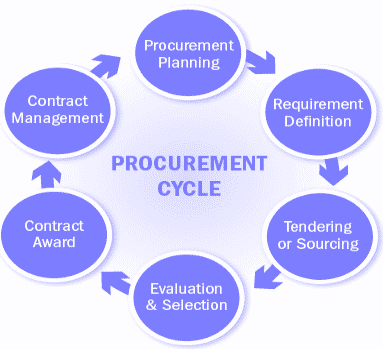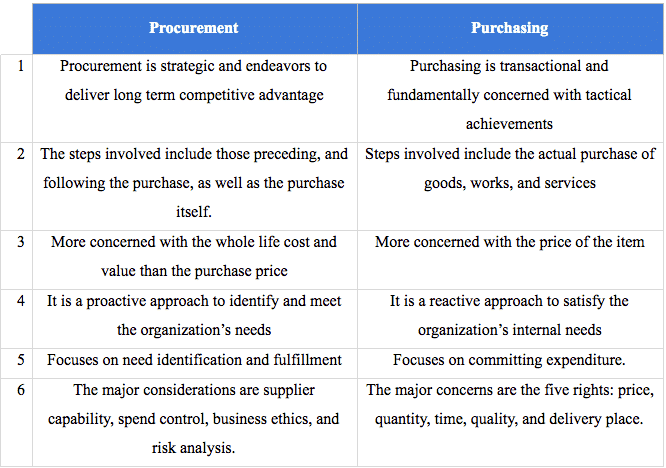You may have used the terms “procurement” and “purchasing” interchangeably, just like most people do. Have you ever asked yourself if you are quite right in so doing? Does procurement mean the same thing as purchasing? Well, before the end of this article you will have an answer to these questions, follow through.
For you to understand if procurement and purchasing mean the same thing, you need to understand what each term means and what it entails.
What is Procurement?
Procurement is a systematic process of acquiring (at the best total cost of ownership) goods, works, and services for an institution – usually referred to as a procuring entity. It is a long-term strategy for acquisition to enhance successful business operations.
When properly aligned with the corporate strategy, the procurement strategy rationally focuses on long-term objectives and incredibly delivers a competitive advantage to the procuring entity.

Stages in a Procurement Cycle
- Need identification and demand planning
- Requisition of goods/works/services
- Purchase Request approval
- Publishing procurement opportunities
- Receiving and analyzing bids.
- Selecting the most suitable suppliers
- Negotiating effectively
- Issuing the purchase order
- Receiving of goods, works, or services
- Inspecting the goods, works, or services.
- Managing the contract
- Invoicing, approval of invoice, and effecting payment
- Developing supplier relationships.
What is Purchasing?
Purchasing is a term associated with the process of buying goods, works, and services needed by the organization.
Purchasing is a small subset of the larger procurement function. The purchasing process is transactional and includes activities like placing orders, receiving goods, and expediting payment.
Stages of the Purchasing Process:
- Collecting and aggregating of needs from different departments through obtaining their purchase requisitions
- Issuing RFQs (Request for quotations) and receiving quotes from prospective suppliers.
- Evaluating the quotes and identifying the best in terms of the five rights.
- Issuing an official purchase order to the best vendor
- Receiving goods, works, and services
- Performing inspection on the received goods, works, and services
- Effecting payment to vendors

Having looked at the two processes, it is important that you now go back to the question:
Procurement vs. purchasing: Do the two terms mean the same thing?
You got it right, the answer is NO! The two terms are distinct, the main difference being the scope of each.
Are you seeing the difference or you are still convinced that procurement and purchasing mean the same thing? Have a look at the outlined differences to get more insight.
In principle, procurement is an all-inclusive set of strategies and practices intended to achieve the highest value of the purchasing. Purchasing on the other hand, is the ultimate result, it is the transaction.
The scope of procurement is much wider than that of purchasing. It includes activities before, during and after the purchase. Purchasing, is the transactional function of procurement. Procurement incorporates the purchasing division into the corporate vision of the organization.
Being a tactical process, purchasing cannot work in isolation with the strategic function that is procurement. Purchasing without a procurement strategy would result in a lack of control, unhealthy supplier relationships, and the inability to minimize spend, among others.

It is important, however, to note that purchasing is an important subset of the procurement process. In most cases, you cannot complete the procurement process without purchasing, unless you are using the specially permitted procedures.
One thing procurement and purchasing have in common is the aspect of quality and quantity.
The next time you want to use the two terms interchangeably, remember the differences given above and make the best choice of the term that will be appropriate for the process you are referring to.


16 comments
Well explained Nancy
well explained Procurement Freelancers Team, good write-up
WOW great arbitration.
It was interesting
Thank you.
Clear picture Procurement Freelancers Team!
Excellent explanation. I have worked with Latin America and Caribbean countries and this is a common missunderstanding. Probably the highest impact i ins with the staff salaries.
So you can share with your network. it’s an interesting article!
Got good knowledge from this column
Really good explanation about procurement and purchase👍
interesting and well explained, thank u!
Excellent presentation of the fundamental activity differences. One additional, quite important contrast is procurement’s responsibility to involve internal, as well as external stakeholders.
Very well explained!!!
Good post. I’m dealing with some of these issues as well..
Hello, after reading this awesome post i am too happy to share
my familiarity here with friends.
Hi this is awesome article and very educative